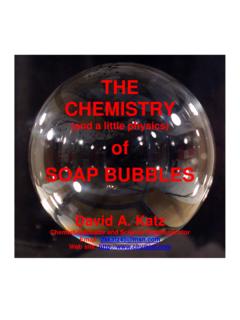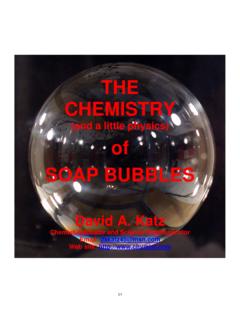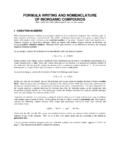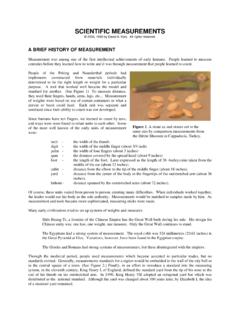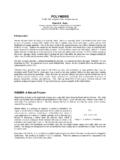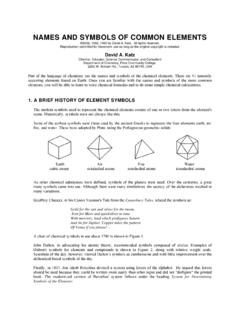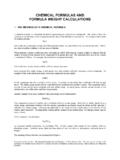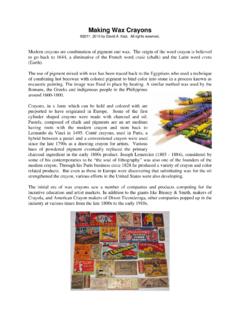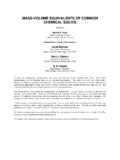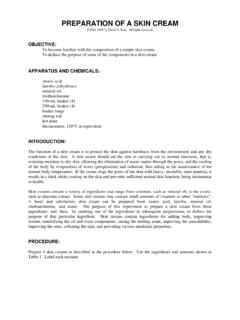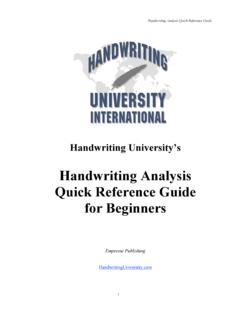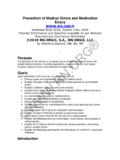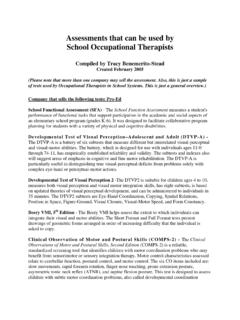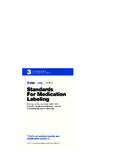Transcription of Handwriting Analysis - chymist.com
1 Handwriting Analysis 2005, 2004, 2002, 1993 by David A. Katz. All rights reserved. Handwritng is unique to each individual. Although some peoples Handwriting may have similar styles and characteristics in common, acquired when these people learned to write by copying letters and words, they tend to take on individual styles with age. Also, as a person ages, their Handwriting will show additional changes. Generally, one cannot determine the age or sex of a suspect or whether they are left-handed or right-handed from a normal writing sample. Certain types of flourishes and embellishments in writing styles and detailed examination of an original document my give hints at some of some of these characteristics.
2 In Handwriting Analysis , one should look for similarities in the shapes, styles, alignment, and spacing of letters. Reference: Reproduced from Saferstein, Criminalistics. 5th Ed., Prentice Hall, 1995. Materials: Documents to be examined Ruler Protractor Magnifying lenses Safety Precautions There are no safety hazards with this procedure. Procedure Never work with original documents. Always make copies to work with. Original documents must be maintained for evidence. Handle original documents as little as possible. Keep them protected in archival sleeves or folders. Any testing for fingerprints must be done after the Handwriting and document Analysis .
3 When requesting writings by a subject, they should be given voluntarily. Dictate the text, never show the subject the original document. Make sure that the subject is comfortable and is using the same type of paper and writing instrument. If other samples of the suspect s Handwriting are available use them for additional comparison. Characteristics of Handwriting Examine the spacing between letters and words. Use a ruler to measure typical spacing. Examine the relative height, width, and size of letters. Use a ruler to measure these for comparison. Examine pen lifts and separations. Some letters and combinations will be continuous while others may not be connected.
4 Look at the beginning and ending strokes of words and letters and any connecting strokes. Are there any unusual letter formations such as loops and curls or a mixture of cursive and printing of letters? Is there any shading of letters due to uneven pressure applied in writing? Examine the slant of the letters. Do they slant left, right, or not at all? Are the slants consistent throughout the writing sample? Measure the angles of slant using a protractor. Examine the baseline habits. Are the words and letters on the baseline or are they above and below. A ruler will be helpful in determining this. Look for flourishes and embellishments.
5 Using small circles to dot i s or for periods, loops on capital letters or ending letters, etc. Are there any unusual letter formations? Look at the placement of diacritics. Are the i s dotted and t s crossed? Individuals tend to dot i s and cross t s in unique fashions. Study the ransom note in Figure H-1. Note some of the unique characteristics of the individual s Handwriting . Figure H-1. A ransom note. Figure H-2 contains samples of Handwriting from 5 suspects. Can you determine who wrote the ransom note shown in Figure H-1? Write your results on the data pages. Figure H-2. Handwriting samples from five suspects.
6 Characteristics of Forged Documents Writing in forged documents tends to be slowly written and will show a lack of individuality. Letters tend to have an unnatural appearance as if the forger was drawing the letters. This makes letters inconsistent in the document, shows unnatural starts and stops and a general lack of rhythm to the writing. Any mistakes will show a careful correction. Signatures will be identical. Reference: Reproduced from Saferstein, Criminalistics. 5th Ed., Prentice Hall, 1995. Try this: Write your signature five times in the spaces below: _____ _____ _____ _____ _____ Now, try to write your signature exactly as you did in the 5th sample, above.
7 _____ Ask your lab partner to write your signature exactly as you did in the 5th sample, above. _____ Complete the information on the data pages. Disguised Writing If a suspect attempts to disguise their writing, they will generally exhibit inconsistent slant and letter formations with a major change in the size of their letters. Capital letters will be different and they often will use block lettering. As they write, there will be a lack of rhythm, irregular spacing, and unnatural starts and stops. Occasionally they will add excessive ornamentation. Some individuals will try to write with the wrong hand.
8 Reference: Reproduced from Saferstein, Criminalistics. 5th Ed., Prentice Hall, 1995. If an independent writing sample is available, it should be used for comparison. Try this: Look at Figure H-2. Write the sentence in the space below. Use your normal writing. _____ Write the sentence again. This time try to make it look different from your normal writing, but try to write at a reasonable rate of speed. _____ Can you write with your other hand? If so, write the sentence again. _____ Complete the information on the data pages. In addition to normal Handwriting Analysis , as discussed previously, methods can be used to detect Handwriting , even when the writing has been obliterated.
9 For example, using infrared film or infrared microscopy, some obliterated writing can be deciphered. Reference: Reproduced from Saferstein, Criminalistics. 5th Ed., Prentice Hall, 1995. Bleaching ink on a document is a method that can be used to alter it, as in the bank check shown below. Ultraviolet light can be used to detect this if the paper, ink, or bleach has any fluorescent properties. Reference: Reproduced from Saferstein, Criminalistics. 5th Ed., Prentice Hall, 1995. Analysis of papers can also be used to compare documents, such as a ransom note. Papers can be compared to those in a home or business to ascertain the source and, in some cases, the manufacturer.
10 The following chart shows the elemental Analysis of different colored papers. Reference: Reproduced from Saferstein, Criminalistics. 5th Ed., Prentice Hall, 1995. Handwriting Analysis Data and Results Name _____ Course and Section _____ Partner(s) _____ Date _____ List your observations and measurements of the Handwriting sample: Spacing of words and letters Relative height, width, and size of letters Are there any pen lifts and separations? Are there any unusual letter formations? Is there any shading of letters? Describe the slant of the writing. Describe the baseline habit of the writer.
